- Home
- The Summer Garden
- Summer Perennials F-O
Summer Perennials from F to O
The list of summer perennials continues . .
Gaura lindheimeri, see Oenothera lindheimeri.
Geranium ‘Rozanne®,’ hybrid geranium, Zones 5-8. ‘Rozanne®’ is a real winner, she just keeps blooming from May until frost with little care. Lovely purple-blue flowers with white centers adorn the plant all season and seem to sparkle in the garden. The foliage is attractive, too, with deeply cut leaves that have a mottled effect. ‘Rozanne®’ forms a mound of about 18-24” but likes to twine through the garden where she effectively keeps out weeds. 2008 Perennial Plant of the Year®. She is so popular she even has her own website, www.geraniumrozanne.com
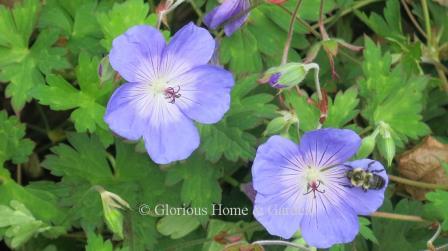
Geum x heidreichii, avens hybrid, Zones 4-7. There are several species and hybrids of geums that are lovely additions to the summer perennial border offering warm colors of yellow, orange and red. They prefer full sun and good drainage and do better in the northern areas of the country. 'Starker's Magnificum' is shown.
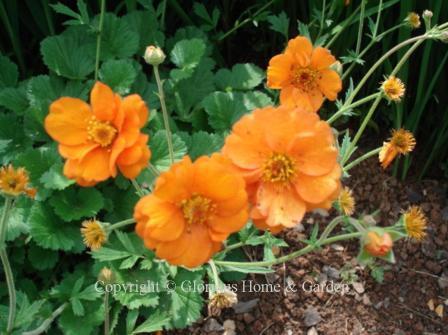 Geum x heidreichii 'Starker's Magnificum'
Geum x heidreichii 'Starker's Magnificum'Glandularia canadensis, rose verbena or vervain, Zones 8-10. Formerly known as Verbena canadensis, trailing verbena is a North American native that is perennial in the warmer zones of the country, but best treated as an annual elsewhere. It produces rounded flower clusters in shades of white, lavender, pink, red, and purple that bloom from late spring into fall. ‘Homestead Purple,’ shown below, is very vigorous, and makes a nice, dense, ground-hugging mat. Other cultivars include ‘Abbeville’ a soft lavender, ‘Appleblossom’ pink, and ‘Snowflurry’ white.
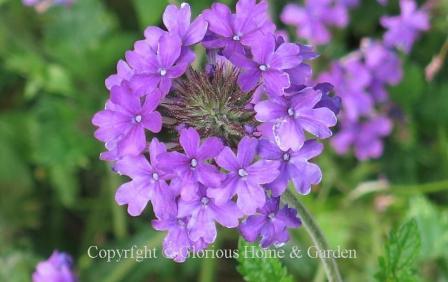 Glandularia canadensis 'Homestead Purple'
Glandularia canadensis 'Homestead Purple'Hemerocallis- Daylilies
Hemerocallis fulva, tawny daylily or ditch lily, Zones 3-9. This is the wild daylily that is commonly seen on roadsides and fields. An import from Asia, it has naturalized throughout much of the country. Tough and long-lived, thrives with neglect. Nice to use in a naturalized area or wildflower meadow.
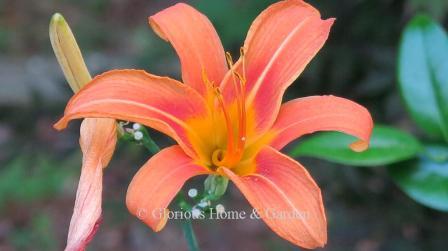 Hemerocallis fulva
Hemerocallis fulvaHemerocallis, hybrid daylily, Zones 3-9. There are few summer perennials that perform like daylilies. Even though each individual flower only lasts a day, a well-established clump produces numerous sturdy scapes with many buds for a long bloom season. They are tough plants, long-lived, vigorous, and only require full sun, adequate water, occasional feeding and dividing to thrive. And the large flowers, in a very wide range of colors and forms are knock-outs in the summer garden. Please visit our daylilies page for more on these outstanding plants.
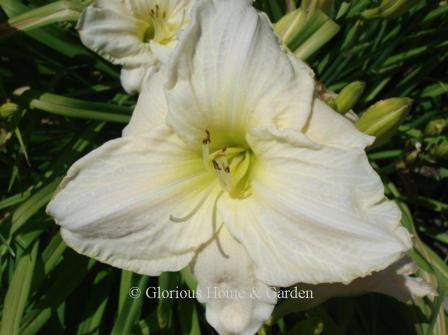 Hemerocallis 'White Temptation'
Hemerocallis 'White Temptation'Hibiscus-Mallow
Hibiscus coccineus, great red hibiscus, swamp hibiscus or scarlet rosemallow, Zones, 6-9. This Southeastern U.S. native is great for the back of the summer border especially if you have a rather moist location, though it will do well in ordinary garden soil as long as it gets full sun and adequate moisture. The tall (up to 6-7’) plants on woody stems stand erect and produce large scarlet-red, distinctly separated five-petaled blooms that create quite an effect. Attractive to butterflies. There is also a white-flowered form, ‘Albus.’
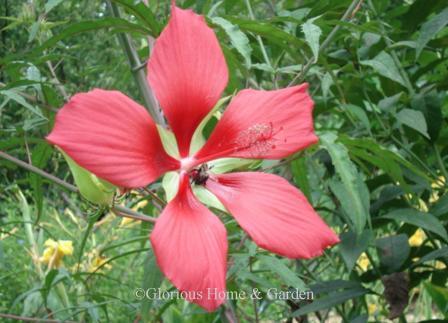 Hibiscus coccineus
Hibiscus coccineus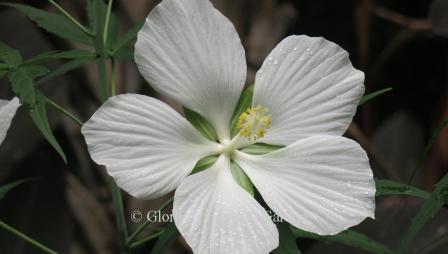 Hibiscus coccineus 'Albus'
Hibiscus coccineus 'Albus'Hibiscus moscheutos, rose mallow or swamp mallow, Zones 5-9. Another Southeastern U.S. native, prefers similar conditions to H. coccineus, though it is not as tall, reaching 2-2 ½’, though some of the cultivars are taller. The showy blooms resemble a giant moonflower or morning glory, but on closer inspection are composed of five overlapping petals, each one pleated like a fan.
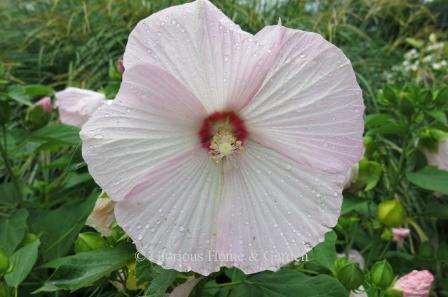 Hibiscus moscheutos 'Disco Bell Pink'
Hibiscus moscheutos 'Disco Bell Pink'Leucanthemum
x superbum, (formerly Chrysanthemum x superbum), Shasta daisy, Zones, 4-9. Who doesn’t love daisies! They are such a cheerful flower with their
ruff of petals and sunny heart. They belong
in every summer perennial bed or border and make great cut flowers for
arrangements. Grow Shasta daisies in full
sun in good garden soil with good drainage.
Removing spent flowers will encourage more blooms. Some varieties to try include ‘Aglaia,’ white
double with thin feathery petals, 18-24”; ‘Banana Cream,’ soft yellow
semi-double of 12-18”; ‘Becky,’ single white, 36 to 42”; ‘Ice Star,’ white
double to 24-30”; and ‘Real Dream,’ yellow semi-double to 35-40." 'Becky' was the 2003 Perennial Plant of the Year.
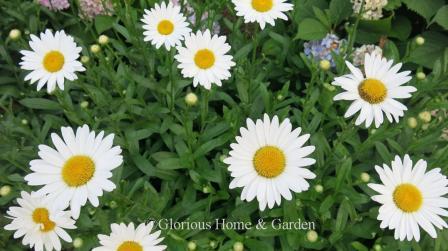 Leucanthemum x superbum 'Becky'
Leucanthemum x superbum 'Becky'Liatris spicata, blazing star or spiked gayfeather, Zones 3-9. Blazing star is a native North American wildflower of the plains and prairies that shoots up tall spikes of pinkish-purple flowers like rockets. Very useful in the summer perennial border as vertical accents. The most popular cultivar is ‘Kobold.’
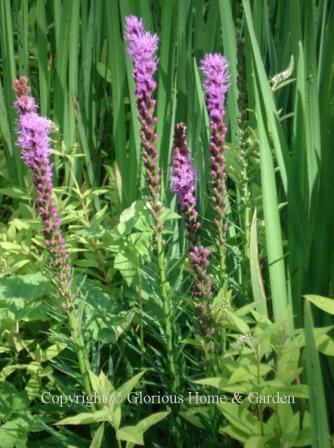 Liatris spicata
Liatris spicataLiriope muscari, blue lily-turf, Zones 6-9. Many a planting bed, border or tree island has been outlined with “monkey-grass” in the South. It has become such a cliché, but still it is eminently suited for the purpose. Spikes of purple flowers rise in summer out of clumps of grassy foliage and are followed by black berries. It is actually an attractive plant when well-grown and makes an excellent evergreen ground cover. The old, tattered foliage should be cut off in late winter or early spring before the new leaves emerge. There are several variations available besides the solid green of the species. ‘Big Blue’ is larger than the species; ‘Monroe’s White’ has white flowers; ‘Variegata’ has variegated green-and-cream foliage; and ‘Silver Dragon’ has leaves striped with white and paler flowers.
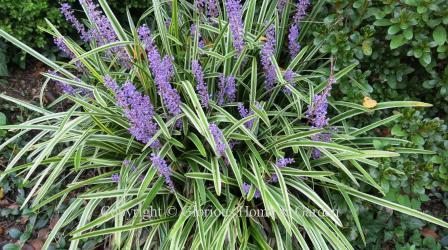 Liriope muscari 'Variegata'
Liriope muscari 'Variegata'Lobelia cardinalis, cardinal flower, Zones 3-9. The flaming spires of this North American native could not be more eye-catching. 2-3’ tall spikes bloom in late summer opening from the bottom up. If you have a sunny, but damp spot in your garden this is a great plant to use in that challenging location as it requires consistent moisture A wonderful butterfly and hummingbird magnet.
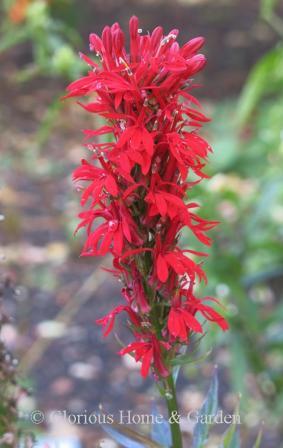 Lobelia cardinalis
Lobelia cardinalisMonarda didyma, bee-balm, Zones 3-7. One summer perennial you must have in your border is bee balm. It is long-blooming and you will be delighted with the color and the bees, butterflies and hummingbirds it will draw to your garden. Grow bee-balm in full sun or partial shade with rich soil and adequate moisture as this North American native is often found near streams in its natural habitat. Leave plenty of room—bee-balm loves to spread by underground rhizomes and can rapidly colonize the garden if allowed free rein), but is easily controlled by regular clump division. Powdery mildrew can be a problem. Providing good air circulation, keeping the soil moist, removing old shoots and raking out the beds at the end of summer and choosing mildew-resistant cultivars will help prevent or reduce powdery mildew.
There are many cultivars available in local nurseries or online sources. Al of these cultivars rate highly for powdery mildew resistance. ‘Dark Ponticum,’ purple, to 40” (rated the highest for mildew resistance in Mt. Cuba Center’s 2014-2016 Monarda Trial); ‘Jacob Cline,’ red, to 50”; ‘Marshall’s Delight’,’ pink, grows about 30-46”; 'Raspberry Wine,' raspberry-purple, is an absolute standout—a real presence in the garden with its gorgeous color and height—and the bees and hummingbirds do love it; and ‘Violet Queen,’ purple, to about 48.”
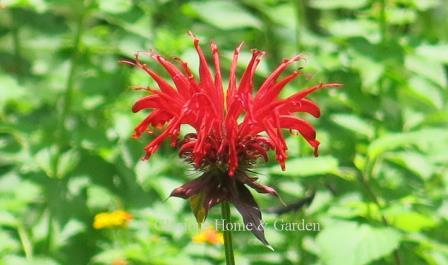 Monarda didyma 'Jacob Cline'
Monarda didyma 'Jacob Cline'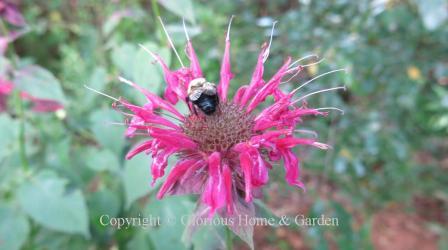 Monarda didyma 'Raspberry Wine'
Monarda didyma 'Raspberry Wine'Monarda punctata, spotted bee-balm or horsemint, Zones 3-9. Spotted bee-balm is a North American wildflower that will make an interesting conversation piece in your summer garden. The actual flowers are clustered in the center and are small and yellow with purple spots, surrounded by decorative pink to lavender bracts growing in tiers. Very attractive to pollinators—bees, butterflies, and hummingbirds will flock to it. Best grown in full to part sun, in sandy soil, drought-tolerant. A short-lived perennial, it spreads by underground rhizomes, but is not considered excessively invasive.
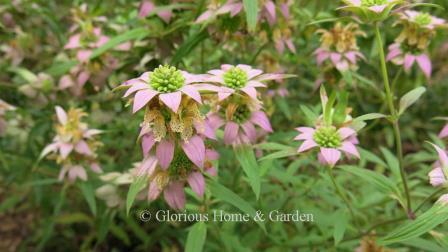 Monarda punctata
Monarda punctataNepeta grandiflora, giant catmint, Zones 4-9. N. grandiflora is a tall-growing (about 30”) species of catmint from the Caucasus. Breeders have been working with different species of nepeta to make better garden perennials, but it seems that most of the new cultivars of N. grandiflora are more readily available in the U.K. than the U.S. at present, such as ‘Summer Magic’ below that I saw at RHS Wisley. Hopefully, they will become available here soon. ‘Summer Magic has showy lavender-blue flowers on tall, sturdy, non-flopping stems, aromatic gray-green leaves and blooms all summer. Other cultivars including ‘Chartreuse on the Loose,’ limey-green foliage contrasted with blue flowers; ‘Dawn to Dusk,’ pink; and ‘Pool Bank,’ a darker blue, are worth seeking out.
 Nepeta x 'Chartreuse on the Loose'
Nepeta x 'Chartreuse on the Loose'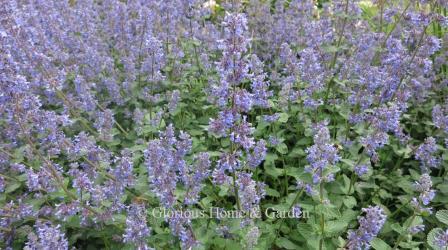 Nepeta grandiflora 'Summer Magic'
Nepeta grandiflora 'Summer Magic'Oenothera lindheimeri, gaura or Lindheimer’s beeblossom, Zones 5-9. Formerly known as Gaura lindheimeri, gaura is a native of Texas and Louisiana, and is a great asset to the summer perennial border. This is a wonderful see-through plant because the airy panicles of tiny white or pink flowers create a sort of gossamer veil. Gaura is easy to grow in full sun with good drainage, and has the further advantage of a long bloom season all summer into fall. Good cultivars include ‘Pink Panache’ with pink flowers and variegated foliage; ‘Siskiyou Pink,’ pink; ‘Whirling Butterflies,’ white.
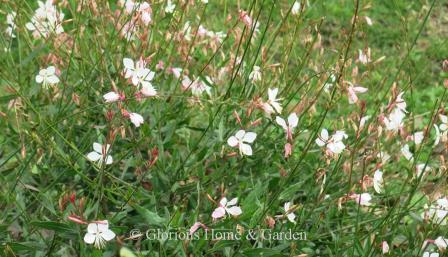 Oenothera lindheimeri
Oenothera lindheimeriPlant of the Month
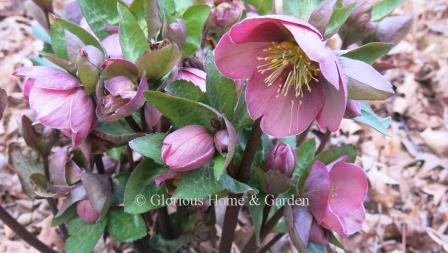
Helleborus x iburgensis
'Pippa's Purple'
Updated new USDA Plant Hardiness Zone Map 2023.